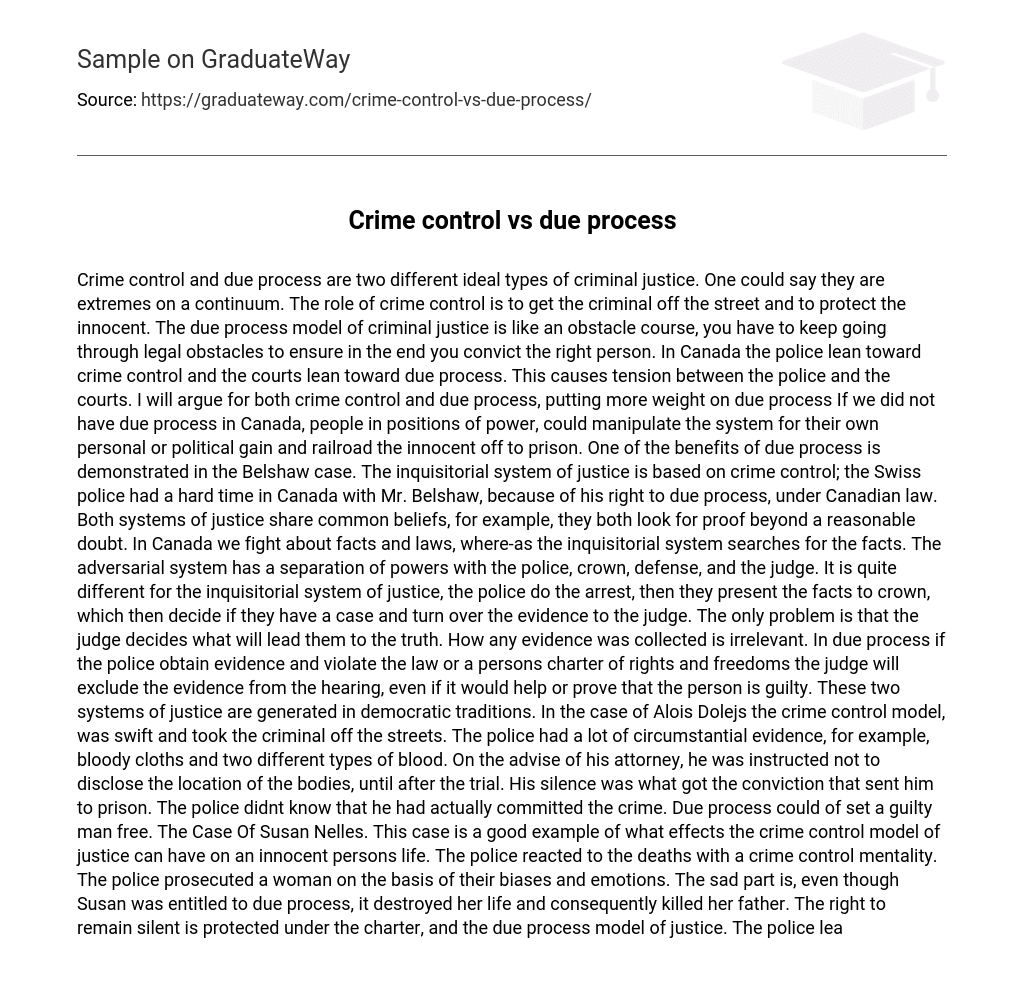Crime control and due process are two contrasting concepts in criminal justice. Crime control aims to eliminate criminals from society and protect the innocent, whereas due process involves handling legal obstacles to ensure the fair conviction of the guilty.
In Canada, the police and courts have differing perspectives on crime control and due process, leading to tension between them. The police prioritize crime control while the courts prioritize due process. While I will support both crime control and due process, I will place emphasis on the significance of due process. It is essential in preventing individuals in positions of power from exploiting the system for personal or political gain and wrongfully imprisoning innocent people.
The advantages of due process are demonstrated in the Belshaw case, as the Swiss police encountered difficulties in Canada because Mr. Belshaw was entitled to his rights under Canadian law. Although both the inquisitorial system and the adversarial system share similar principles, such as the requirement for proof beyond a reasonable doubt, they vary in certain aspects. In Canada, emphasis is placed on questioning facts and laws, while the inquisitorial system prioritizes finding facts. The adversarial system maintains a division of powers among the police, crown, defense, and judge.
The police in the inquisitorial system of justice are responsible for making arrests and presenting facts to the crown. The crown then assesses whether there is a case and transfers evidence to the judge for evaluation. However, it is ultimately up to the judge to determine which evidence will reveal the truth, regardless of its collection methods. In contrast, in the due process system, if law enforcement acquires evidence unlawfully or violates someone’s rights and freedoms, that evidence will be ignored by the judge during proceedings – even if it could establish guilt.
These two justice systems both stem from democratic traditions. In Alois Dolejs’ case, the crime control model was enacted swiftly, removing the criminal from the streets. The police possessed substantial circumstantial evidence, such as bloody clothes and two different blood types. Following his attorney’s guidance, Dolejs refrained from revealing the bodies’ location until after the trial. It was his silence that led to the conviction sending him to prison. The police were unaware that he was indeed the perpetrator. The application of due process could have resulted in the release of an innocent man.
The Case Of Susan Nelles showcases how the crime control model of justice can harm an innocent person’s life. The police reacted to the deaths with a crime control perspective, which caused them to unjustly accuse a woman due to their own biases and emotions. Regrettably, despite Susan’s entitlement to fair treatment, it ultimately destroyed her life and tragically led to her father’s demise. It is crucial to acknowledge that the charter protects the right to stay silent as part of the due process model of justice.
The press was informed by the police about the incident, which led to a public trial for this woman and raised concerns about the due process model. Instead of going through proper court proceedings, an innocent person had to endure a clear injustice. The case of James Keegstra serves as a prominent example that exposes a longstanding flaw in due process. Section 2.b of the charter of rights and freedoms ensures our fundamental freedoms, including thoughts, beliefs, opinions, and expressions, along with freedom of the press and other forms of communication. However, this situation demonstrates that these rights have certain limitations. It wasn’t just what he said but also how and where he exercised his right to free speech. Nonetheless, we still maintain our right to free speech and ultimately witnessed justice prevailing in this particular case.
If I were the crown in this case, my charge would be based on section 319 (1), (2), and (3). In my view, he deliberately targeted the Jewish faith and chose to publicly oppress them, specifically within a school. The supreme court of Canada ultimately ruled against him.
The Donald Marshall Case is an example of the evil that exists in crime control. Despite the presence of due process, justice failed for Mr. Marshall. The police officer responsible for the investigation should have been incarcerated. I still have faith in the due process model of justice. Most individuals in the criminal justice field are trustworthy and genuinely strive to uphold the law. However, there are a few corrupt individuals who still hold positions of authority within the Canadian justice system. Gradually, due process will remove these individuals from their positions one by one.
The common objective of both criminal justice models is to ensure the conviction of the guilty while also ensuring the release of the innocent. Crime control and due process models have four shared values, which are:
- crime should only be defined by law,
- crime should lead to some form of legal intervention,
- criminal justice system power should be legally limited,
- criminal justice system should be adversarial.
The case studies addressed important aspects of crime control and due process. Both models expressed concerns that had a profound impact on real individuals, which was deeply unsettling to me. While it is true that innocent individuals may occasionally be wrongly imprisoned, this only begins to uncover the injustices that would occur in our country if both models did not work together to establish justice in Canada. Our justice system will always face criticism from those who wish to reshape the law based on their own ideologies and beliefs. In Canada, factors such as social standing, age, race, and religion greatly influence an individual’s success. After completing sociology 101 and 102, I find it difficult to deny that many social injustices have happened and will continue to happen. Nevertheless, I still support the due process model of criminal justice. In conclusion, I believe we need a balance between crime control and a strong emphasis on due process in our criminal justice system.





